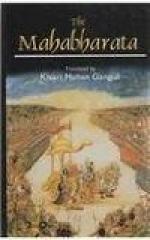11. i.e., content to work on receiving their food only. Their wages should not be higher that’ what is needed to feed them.
12. The word Mandala has been explained below in verse 5. The distinction between Udasinas and Madhyasthas, as explained by Nilakantha, is that the former are neutrals, while the latter are those who cherish equal sentiments towards both the parties.
13. The four kinds of foes, as explained by the commentator, are (1) foes proper, (2) allies of foes, (3) those that wish victory to both sides, and (4) those that wish defeat to both sides. As regards Atatayins, they are six, viz., (1) he that sets fire to one’s house, (2) he that mixes poison with one’s food, (3) he that advances, weapon in hand, with hostile intent, (4) he that robs one of one’s wealth, (5) he that invades one’s fields, and (6) he that steals one’s wife.
14. The sixty are thus made up. Eight consisting of agriculture and the rest; twenty-eight consisting of forces and the rest; fourteen consisting of atheists and the rest and eighteen consisting of counsels and the rest.
15. i.e., land that is fertile, gold that is pure, and men that are strong.
16. The wards Kasyanchidapadi should be construed with what follows.
17. The cane yields when pressure is directed towards it. In the Santi Parva occurs the detailed conversation between the Ocean and the Rivers. The former enquired why, when the Rivers washed down the largest trees, they could not wash into the Ocean a single cane. The answer was that the cane was yielding; the trees were not so.
18. War and peace are each of two kinds, i.e., war with a strong foe and that with a weak foe: peace with a strong foe and that with a weak foe. The Bengal texts wrongly read dividhopayam or vividhopayam.
19. I expand this verse a little, following the commentator.
20. Strength is of three kinds, as explained in the next verse.
21. Utsaha is readiness or alacrity, of the forces to attack the foe: prabhusakti is the complete mastery of the king over his forces, i.e., through discipline. By strength of counsels, in this connection, is meant well-formed plans of attack and defence.
22. Maulam is explained as the strength of money. In modern warfare also, money is called ‘the sinews of war’. Atavivala or the force consisting of foresters, was, perhaps, the body of Irregulars that supported a regular army of combatants. Bhritavala implies the regular army, drawing pay from the state at all times. In India, standing armies have existed from remote times. Sreni-vala is, perhaps, the forces of artisans, mechanics, and engineers, who looked after the roads and the transport, as also of traders who supplied the army with provision.
23. A sakata array was an array after the form of a car. It is described in Sukraniti fully, and occurs in the Drona Parva, ante. The Padma is a circular array with angular projections. It is the same with what is now called the starry with angular projections. It is the same what is now called the starry array, many modern forts being constructed on this plan. The Vajra is a wedge-like array. It penetrates into the enemy’s divisions like a wedge and goes out, routing the foe. It is otherwise called suchivyuha.




